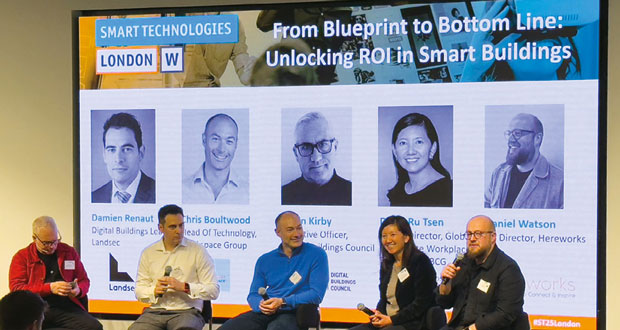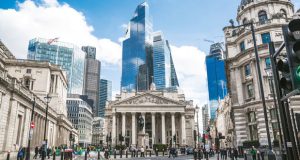 It was apt that WORKTECH’s Smart Technologies25 London conference, exploring the next generation of intelligent buildings and workspaces took place at WeWork London. Sara Bean reports
It was apt that WORKTECH’s Smart Technologies25 London conference, exploring the next generation of intelligent buildings and workspaces took place at WeWork London. Sara Bean reports
WeWork Waterloo is billed as the world’s largest coworking office, offering pet friendly space, kitchen pantries and trendy bar/coffee areas. It was an appropriate place to hold a conference on smart workplaces, as this event didn’t feature endless sessions on BMS and building assets, but rather how tech can improve the workplace experience.
In her keynote address on the role of data driven innovation, Director of Unwork Imogen Privett advised when it comes to thinking about the digital workplace journey, “be more Disney”. The Disney theme parks she explained use tech innovation to shape visitors’ experiences. Applying this approach to the office she suggested, delivers a user centred approach resulting in a friction free day with seamless transitions across the workspace.
The autonomous building is becoming a reality said Elisa Rönkä of Kasvu Growth Hub and guest lecturer at Cambridge University. Agentic AI, which can make decisions without human intervention is beginning to automate tasks such as diagnostics, maintenance requests and workflow management, leaving FMs opportunities to focus on the experience side. This could mean a repurposing and redefining of the FM role, but the sector needs to be careful it’s not overridden by IT she warned.
In a panel session exploring the latest trends in technology innovation, Dan Drogman CEO at Smart Spaces said people don’t just move physically but digitally at work, so developers must take a leaf out of the consumer side and offer the convenience factor to encourage adoption. One example is the now ubiquitous Apple Pay which was first approached with some trepidation over privacy concerns.
THE POWER OF DATA
People have different needs at different times said Arjun Kaicker from Zaha Hadid Architects so let’s utilise AI to match people to place. For instance, an occupant’s environmental needs depend on a variety of factors and agentic AI can work out ideal places to sit rather than just what is available.
Matthew Potter, Head of Workplace Experience Technology, HSBC echoed this approach. The digital experience has gone from “give me a space’ to a much more personalised, ‘help me plan my day”. But avoid investing in the “new and shiny” he warned – aim for a process of evolution rather than revolution.
During a panel session on return on investment, Damien Renaut from Landsec said the relationship between landlords and tenants is a key aspect for unlocking ROI in Smart Buildings. The challenge is to manage the volume of tech that is often deployed by occupants and landlords within every building, he said, which is why all stakeholders must work together. However, Chris Boultwood of Workspace Group added, while ROI is often approached by measuring the value of the real estate space, there is also significant ROI factor in improving recruitment/retention and reducing churn.
CONNECTED WORKPLACE
Introducing the last panel of the day Jonathan Mills of Osborne Clarke LLP said future work is influenced by changing societal expectations as employees today seek flexibility more than ever before. This shift towards flexible, dynamic and employee centric work means organisations must rethink traditional office settings to offer a wealth of experiences which drive innovation and creativity.
Reflecting the event’s coworking setting Tom Redmayne from coworking specialists Industrious offered some insights into how organisations are utilising these spaces. A lot of enterprise businesses don’t want a single office he said and instead make “fractional purchases” where rooms are booked for hours or days. Flex strategies also mean corporate companies will concentrate on high quality fitouts in their regional HQs and as leases on other buildings come to an end replace them with flex spaces.
Providing a bespoke solution is a key part in delivering the connected workplace said proptech provider Jack Sibley. Some organisations may want to create an environment where occupants don’t want to leave, or FMs might want to concentrate on making energy savings backed up with strong governance to make sure they’re managing risk. But the overriding purpose of smart workplaces argued Laura Woolcock of Savills is to provide flexible, customisable spaces over generic programming with an ability to personalise your space.
In the last presentation of the day, Ibrahim Yate from JLLT brought the discussion back to the human experience and the fact that one size won’t fit all. He argued the root problem of the controversial return to work mandates is a lack of definition on what is a workplace and not enough thought on ways of integrating remote and in-office environments.
The key message of the day was to move beyond utilisation targets and instead reframe the smart workplace where employees are seen as customers. In this way HR and FM are the product managers who utilise smart technology to figure out user demand and provide a better return on experience for occupants.





